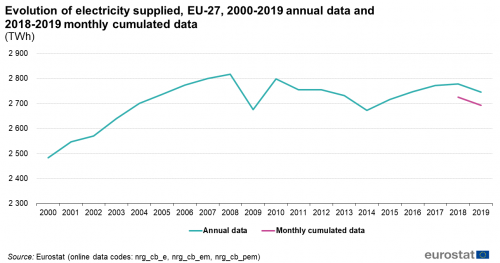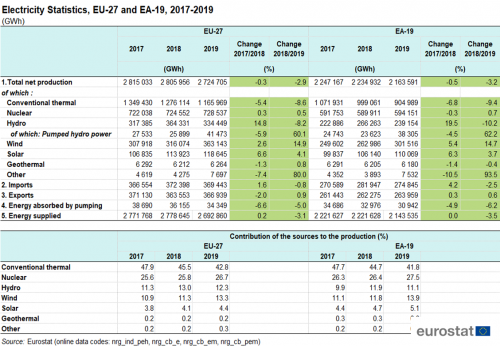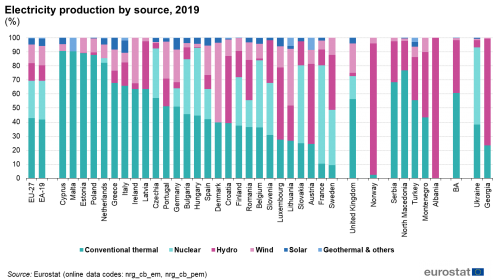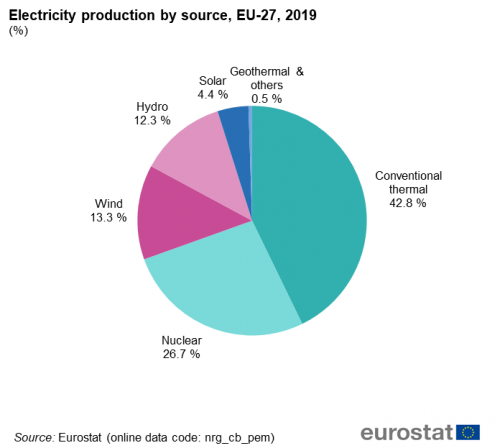Archive:Electricity generation statistics – first results
Data extracted in July 2020.
Planned article update: August 2021.
Highlights
Supply of electricity in the EU decreased by 1.2 % in 2019 compared with 2018.
Production of electricity from wind increased in the EU in 2019 by 14.9 % compared with 2018.
Production of electricity from hydro and conventional thermal decreased in the EU in 2019 by 8.2 % and 8.6 % respectively compared with 2018.
Evolution of electricity supplied, EU-27, 2000-2019 annual data and 2018-2019 monthly cumulated data
This article takes a look at the most recent statistics (2019) monthly electricity cumulated data (nrg_cb_em and nrg_cb_pem), annual electricity data (nrg_cb_e for 2000 to 2018) and provisional 2019 electricity annual data as voluntarily supplied by Member States on the volumes of electricity that have been produced and supplied at the level of the European Union (EU), the euro area (EA-19) and at the level of individual countries.
Full article
Production of electricity
As illustrated by Figure 1, the supply of electricity in the EU decreased slightly (-1.2%) in 2019 compared with 2018.
<image zoom="100">
(TWh)
Source: Eurostat (nrg_cb_e), (nrg_cb_em), (nrg_cb_pem)
The volume of produced electricity at EU level increased from 2 484 TWh in 2000 to its peak of 2 818 TWh in 2008. In 2019, the electricity supplied decreased slightly compared with 2018 by 1.2 % and reached 2 745 TWh, but showed a decrease of 2.6 % compared with the 2008 peak value.
Table 1 shows the production and supply data for the EU and EA-19. Tables A to M (see: Source data for tables and graphs on this page) show the production and supply data for all individual EU Member States and other countries that reported data, by using monthly cumulated data for 2019 (2017 and 2018 data are annual figures).
<image zoom="100">
(GWh)
Source: Eurostat (nrg_ind_peh), (nrg_cb_e), (nrg_cb_em), (nrg_cb_pem)
Belgium (+20.6 %), Lithuania (+11.0 %), Austria (+9.0 %), Hungary (+7.0 %) and the Netherlands (+5.5 %) were the Member States that recorded the largest increases in net electricity production in 2019. Other Member States that recorded small increases (less than 2 %) were Italy (+1.4 %), Cyprus (+1.2 %) and Czechia (+0.3 %). Against this trend, net electricity production decreased most significantly in Estonia (-41.1 %), Luxembourg (-15.6 %), Germany (-11.3 %), Portugal (-10.9 %), Romania (-10.5 %) and Bulgaria (-5.7 %).
As regards the structure of electricity production (Figures 2, 3 and Table 1), the production of conventional thermal electricity decreased by 8.6 % in the EU in 2019 and accounted for 42.8 % of the total production, while the production of electricity by nuclear power plants increased only slightly (+0.5 %) and accounted for 26.7 % of the total. The electricity production in the EU by wind increased by 14.9 % and represented 13.3 % of the total production, while the production by hydro which includes pumped hydro (not necessarily of renewable origin) decreased by 8.2 % and represented 12.3 % of the total production. The electricity production by solar increased by 4.1 % and represented 4.4 % of the total production.
<image zoom="100">As mentioned above, electricity produced by nuclear power plants increased by 0.5 % between 2018 and 2019. In 2019, the largest shares of electricity produced by nuclear power in the 13 EU Member States that have nuclear facilities to produce electricity were observed in France (69.9 %), followed by Slovakia (55.3 %), Hungary (48.3 %), Belgium (47.6 %), Sweden (39.1 %), Bulgaria (39.0 %), Slovenia (37.0 %), Czechia (35.2 %) and Finland (34.7 %). In Germany, where it was decided to close down their nuclear power plants by the year 2022, the share of electricity produced by nuclear power is 13.1 % of the total.
Electricity supplied to the market
The volume of electricity supplied to the market is defined as the total net volume of electricity produced minus export plus import minus the electricity absorbed by pumping (pumped storage). As illustrated in Figure 1, the supply of electricity in the EU recorded a decrease of 1.2 % in 2019 compared with 2018. When looking at supply statistics at national level, the largest increases were observed in Malta (+3.8 %), Latvia (+2.6 %) and Greece (2.4 %). Small increases of less than 2 % were observed in 4 other Member States (Czechia, Cyprus, Hungary and Austria). The largest decreases in supply figures were observed in Germany (-9.5 %), Estonia (-4.9 %), Belgium (-4.7 %), Romania, Slovenia, Sweden (-2.9 % each), Ireland (-2.8 %), Spain (-2.6 %) and Slovakia (-2.5 %). Small decreases of less than 2 % were observed in 11 other Member States
In 2019, the aggregated EU imports of electricity decreased by 0.8 % and exports increased by 0.9 %.
<image zoom="100">
(%)
Source: Eurostat (nrg_cb_em), (nrg_cb_pem)
Source data for tables and graphs
Direct access to
Other articles
- Electricity and heat statistics
- Energy statistics - an overview
- Electricity, gas, steam and air conditioning supply statistics - NACE Rev. 2
- Electricity market indicators
- Electricity production, consumption and market overview
- Electricity price statistics
- Natural gas price statistics
- Energy price statistics - background
- Energy production and imports
Publications
- Energy balance sheets — 2017 data — 2019 edition
- Energy balance sheets — 2016 data — 2018 edition
- Energy, transport and environment statistics — 2019 edition
- Shedding light on energy in the EU — A guided tour of energy statistics (digital publication) — 2017 edition
- Energy flow charts (Sankey diagrams), electricity
Main tables
- Energy (t_nrg), see:
- Energy Statistics - main indicators (t_nrg_indic)
- Market share of the largest generator in the electricity market (ten00119)
- Electricity prices by type of user (ten00117)
Database
- Energy (nrg), see:
- Energy statistics - quantities, annual data (nrg_quanta)
- Supply, transformation and consumption - commodity balances (nrg_cb)
- Supply, transformation and consumption of electricity (nrg_cb_e)
- Supply, transformation and consumption - commodity balances (nrg_cb)
- Energy indicators (nrg_ind)
- Gross and net production of electricity and derived heat by type of plant and operator (nrg_ind_peh)
- Energy indicators (nrg_ind)
- Energy infrastructure and capacities (nrg_inf)
- Energy statistics - quantities, monthly data (nrg_quantm)
- Supply, transformation and consumption of electricity - monthly data (nrg_cb_em)
- Energy statistics - market structure indicators - natural gas and electricity (nrg_market)
- Market share of the largest generator in the electricity market - annual data (nrg_ind_331a)
Dedicated section
Methodology
- Electricity production capacities by main fuel groups and operator (nrg_inf_epc) (ESMS metadata file — nrg_inf_epc_esms)
- Supply, transformation and consumption — commodity balances (ESMS metadata file — nrg_cb_esms)
- Energy statistics - quantities (nrg_quant) (ESMS metadata file — nrg_indic_esms)
Legislation
- Directive 2009/72/EC of 13 July 2009 concerning common rules for the internal market in electricity
- Summaries of EU legislation: Internal market in electricity
- Regulation (EC) No 1099/2008 of 22 October 2008 on energy statistics
- Summaries of EU legislation: Common system for the production of energy statistics
- Regulation (EC) No 713/2009 of 13 July 2009 establishing an Agency for the Cooperation of Energy Regulators
- Summaries of EU legislation: Agency for cooperation between EU energy regulators
- Regulation (EC) No714/2009 of 13 July 2009 on conditions for access to the network for cross-border exchanges in electricity
- Summaries of EU legislation: Cross-border exchanges in electricity
- Regulation (EU) No 844/2010 of 20 September 2010 on energy statistics, as regards the establishment of a set of annual nuclear statistics and the adaptation of the methodological references according to NACE Rev. 2
